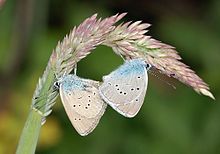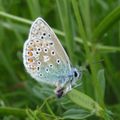- Lycaenidae
-
Lycaenidae 
Peablue
Lampides boeticusScientific classification Kingdom: Animalia Phylum: Arthropoda Subphylum: Hexapoda Class: Insecta Order: Lepidoptera (unranked): Rhopalocera Superfamily: Papilionoidea Family: Lycaenidae
Leach, 1815Subfamilies Curetinae – Sunbeams
Liphyrinae
Lipteninae
Lycaeninae – Coppers
Miletinae – Harvesters
Polyommatinae – Blues
Poritiinae
Theclinae – Hairstreaks, Elfins
and see text or
List of lycaenid generaThe Lycaenidae are the second-largest family of butterflies, with about 6000 species worldwide,[1] whose members are also called gossamer-winged butterflies. They constitute about 40% of the known butterfly species.[2]
The family is traditionally divided into the subfamilies of the blues (Polyommatinae), the coppers (Lycaeninae), the hairstreaks (Theclinae) and the harvesters (Miletinae); others include the Lipteninae, Liphyrinae, Curetinae and Poritiinae. A few authorities still include the family Riodinidae within the Lycaenidae. The monotypic former subfamily Styginae represented by Styx infernalis from the Peruvian Andes has been placed within the subfamily Euselasiinae[3] of the family Riodinidae.[4]
Adults are small, under 5 cm usually, and brightly coloured, sometimes with a metallic gloss. The male's forelegs are reduced in size and lack claws.
Larvae are often flattened rather than cylindrical, with glands that may produce secretions that attract and subdue ants. Their cuticles tend to be thickened. Some larva are capable of producing vibrations and low sounds that are transmitted through the substrates they inhabit. They use these sounds to communicate with ants.[5][6]
Adult individuals often have hairy antenna-like tails complete with black and white annulated appearance. Many species also have a spot at the base of the tail and some turn around upon landing to confuse potential predators from recognizing the true head orientation. This causes predators to approach from the true head end resulting in early visual detection.[7]
Contents
Ecology
Lycaenids are diverse in their food habits and apart from phytophagy, some of them are entomophagous feeding on aphids, scale insects and ant larvae. Some Lycaenids even exploit their association with ants by inducing ants to feed them by regurgitation, a process called trophallaxis. Not all Lycaenid butterflies need ants, but about 75% of species associate with ants.[5] The term used to describe such ant association is myrmecophily. These associations can be mutualistic, parasitic or predatory, depending on the species.
In some species, larvae are attended and protected by ants while feeding on the host plant, and the ants receive sugar-rich honeydew from them, throughout the larval life. In other species, only the first few instars are spent on the plant, and the remainder of the larval lifespan is spent as a predator within the ant nest. It becomes a parasite, feeding on ant regurgitations, or a predator on the ant larvae.[5] The caterpillars pupate inside the ant's nest and the ants continue to look after the pupa. Just before the adult emerges the wings of the butterfly inside the pupal case detach from it, and the pupa becomes silvery. The adult butterfly emerges from the pupa after 3–4 weeks, still inside the ant nest. The butterfly must crawl out of the ant nest before it can expand its wings.
Several evolutionary adaptations enable these associations and they include small glands on the skin of the caterpillars called pore cupola organs. Caterpillars of many species except those of the Riodininae have a gland on the 7th abdominal segment that produces honey dew and is called the dorsal nectary gland (also called Newcomer's gland). An eversible organ called the tentacular organ is present on the 8th abdominal segment (third segment of thorax in the Riodininae) and this is cylindrical and topped with a ring of spikes and emits chemical signals which are believed to help in communicating with ants.[8]
As many as 30% of world's threatened butterflies are lycaenid.
Subfamilies
Many taxonomists include only the Lycaeninae, Poritiinae, Miletinae and Curetinae under the Lycaenidae.[9][10]
The genus Chrysoritis is included with Lycaenidae but has not been assigned to a subfamily.
Other classifications notably include the Riodininae (e.g., Abisara echerius).[11]
Curetinae
Poritiinae Pentilini
Liptenini
Poritiini
Miletinae Lacnocnemini
Liphyrini
Miletini
Spalgini
Lycaeninae Aphnaeini
Lycaenini
Polyommatini
Theclini
Phylogeny of the family.[4]
- Lipteninae (Afrotropical)
- Poritiinae (Oriental)
- Liphyrinae (mostly African, some Asian)
- Liphyra brassolis – Moth Butterfly (largest lycaenid)
- Miletinae – Harvesters (mostly African, or Oriental, some Holarctic). Probably all feed on aphids or their secretions.
- Curetinae – Sunbeams (Oriental or Palaearctic)
- Curetis thetis – Indian Sunbeam
- Theclinae – Hairstreaks (usually tailed) and Elfins (not tailed) (global)
- Satyrium pruni – Black Hairstreak
- Atlides halesus – Great Purple Hairstreak
- Eumaeus atala – Atala
- Lycaeninae – Coppers (Holarctic)
- Lycaena boldenarum – Boulder Copper
- Lycaena feredayi – Glade Copper
- Lycaena rauparaha – Rauparaha’s Copper
- Lycaena salustius – Common Copper
- Lycaena dispar – Large Copper
- Lycaena phlaeas – Small Copper
- Talicada nyseus – Red Pierrot
- Polyommatinae – Blues (global)
- Celastrina neglecta – Summer Azure
- Celastrina ladon – Spring Azure
- Cupido comyntas – Eastern Tailed-blue
- Cupido minimus – Small Blue
- Euphilotes battoides allyni – El Segundo Blue
- Euphilotes pallescens arenamontana – Sand Mountain Blue
- Jameela palmyra
- Jameela albiplaga
- Polyommatus icarus – Common Blue
- Polyommatus semiargus – Mazarine Blue
- Glaucopsyche lygdamus – Silvery Blue
- Glaucopsyche lygdamus palosverdesensis – Palos Verdes Blue
- Glaucopsyche xerces (extinct) – Xerces Blue
- Plebejus argus – Silver-studded Blue
- Maculinea arion – Large Blue
- Icaricia icarioides fenderi – Fender's Blue
- Pseudozizeeria maha – Pale Grass Blue
Gallery
-
Common Blue (Polyommatus icarus)
-
Dark Cerulean (Jamides bochus)
-
Common Lineblue (Prosotas nora)
-
Pale Grass Blue (Pseudozizeeria maha)
See also
References
- ^ Fiedler, K. 1996. Host-plant relationships of lycaenid butterflies: large-scale patterns, interactions with plant chemistry, and mutualism with ants. Entomologia Experimentalis et Applicata 80(1):259-267 doi:10.1007/BF00194770 [1]
- ^ Venkatesha, MG. 2005. Why is homopterophagous butterfly, Spalgis epius (Westwood) (Lepidoptera: Lycaenidae) amyrmecophilous? Current Science 89 (2): 245-246. [2]
- ^ Hall J.P.W. & Harvey DJ. (2002) A survey of androconial organs in the Riodinidae (Lepidoptera). Zoological Journal of the Linnean Society, 136:171-197
- ^ a b Brower, Andrew V. Z. 2007. Riodinidae Grote 1895. Metalmarks, Erycinidae Swainson 1827 (see nomenclature section). Version 19 May 2007 [3] in The Tree of Life Web Project, [4]
- ^ a b c Pierce NE, Braby MF, Heath A, Lohman DJ, Mathew J, Rand DB, Travassos MA. 2002. The ecology and evolution of ant association in the Lycaenidae (Lepidoptera.) Annual Review of Entomology 47: 733-771. PDF
- ^ DeVries, Philip J. 1992. Singing Caterpillars, Ants and Symbiosis. Scientific American, 267:76
- ^ Robbins, Robert K. 1981 The "False Head" Hypothesis: Predation and Wing Pattern Variation of Lycaenid Butterflies. American Naturalist, 118(5):770-775
- ^ Australian Museum factsheets Accessed 4 November 2010 on the Wayback Machine.
- ^ Maddison, David R. 2003. Lycaenidae. Version 01 January 2003 (temporary). [5] in The Tree of Life Web Project, [6]
- ^ Ackery, P. R., R. de Jong, and R. I. Vane-Wright. 1999. The butterflies: Hedyloidea, Hesperioidea, and Papilionoidea. Pages 264-300 in: Lepidoptera: Moths and Butterflies. 1. Evolution, Systematics, and Biogeography. Handbook of Zoology Vol. IV, Part 35. N. P. Kristensen, ed. De Gruyter, Berlin and New York.
- ^ Scoble, MJ. 1992. The Lepidoptera: Form, Function and Diversity. Oxford University Press. ISBN 0-19-854952-0
External links
- Tree of Life
- BugGuide.net
- Family Lycaenidae at Lepidoptera.pro
- Lycaenidae at National Center for Biotechnology Information (NCBI) website.
- ITIS
- Lycaenidae at the Encyclopedia of Life
Categories:- Butterflies
- Lycaenidae
- Insect families
Wikimedia Foundation. 2010.








